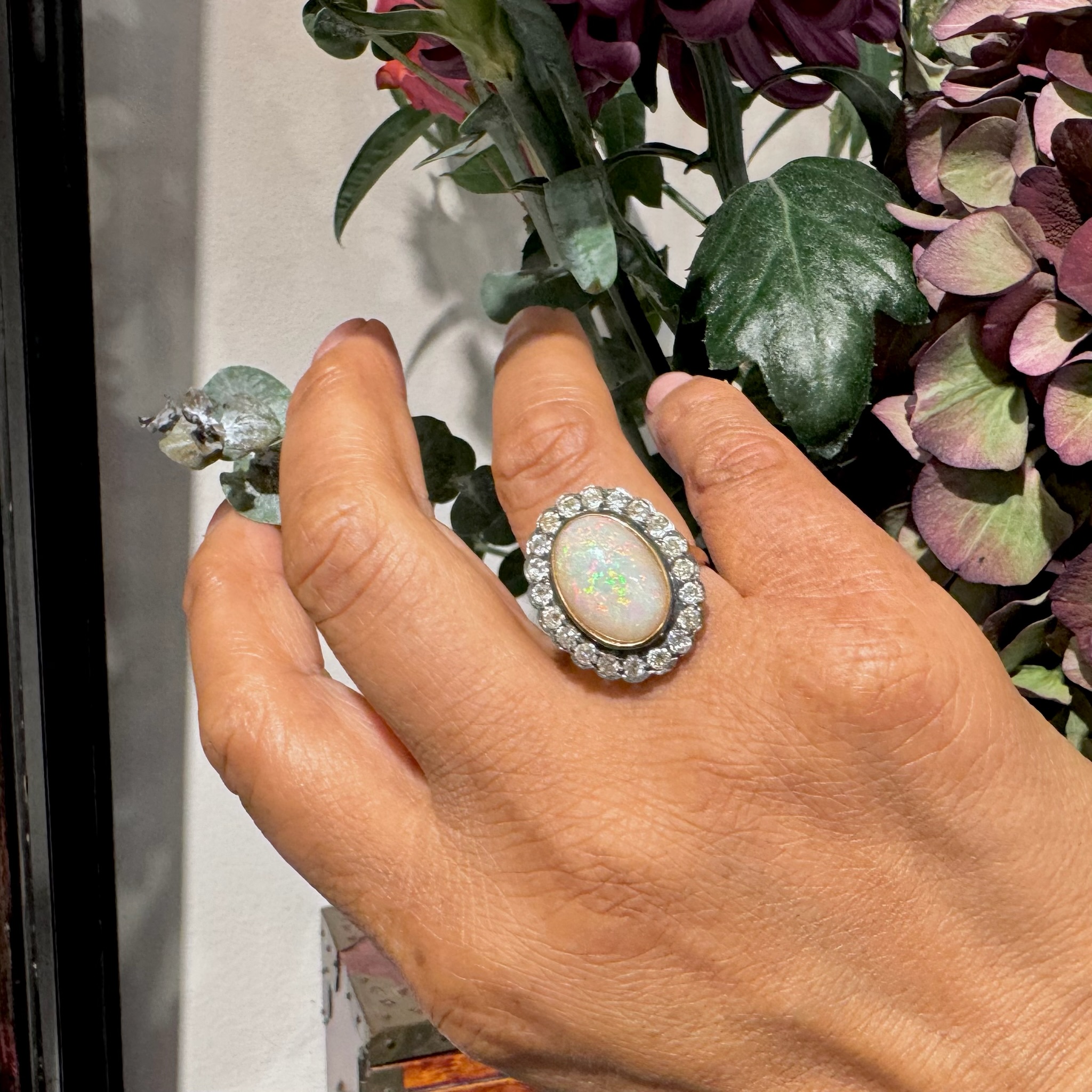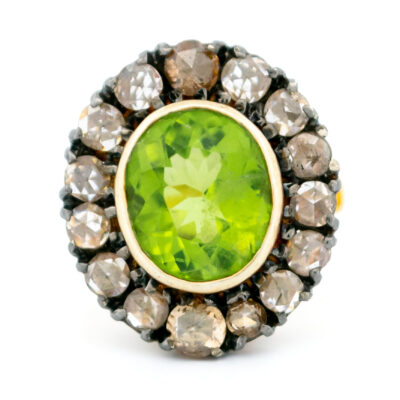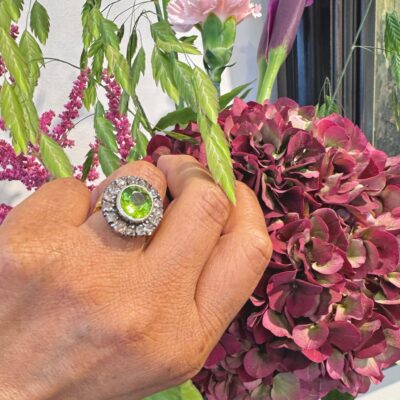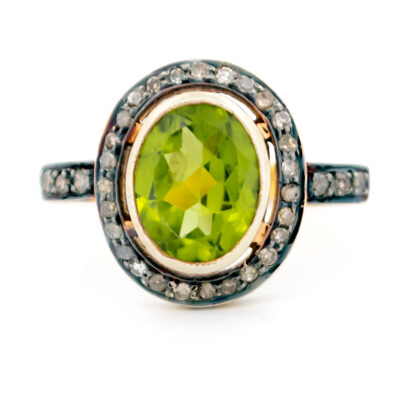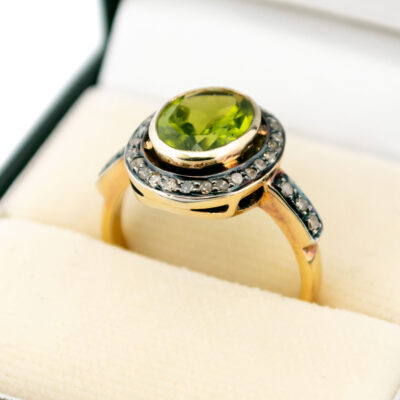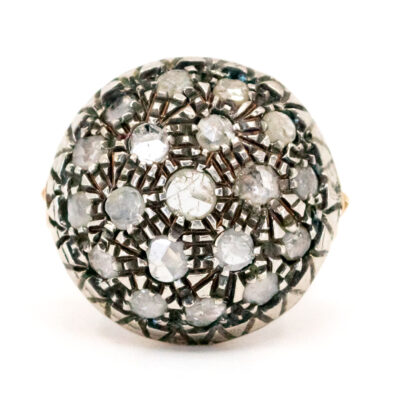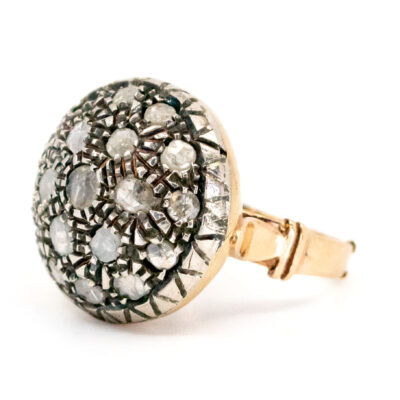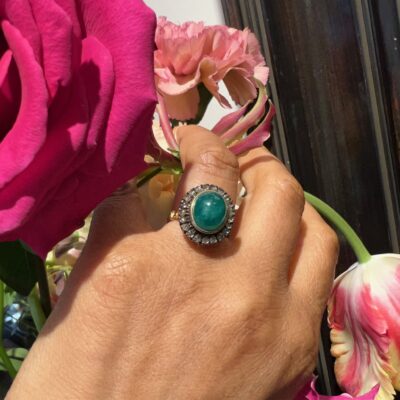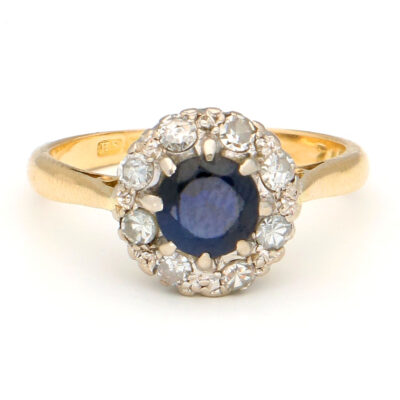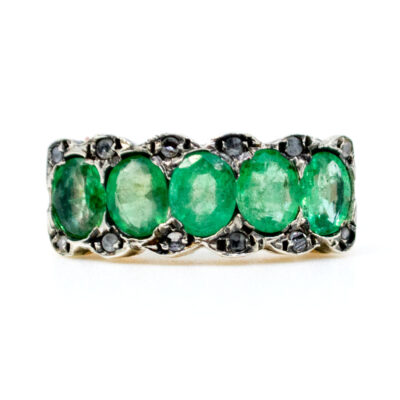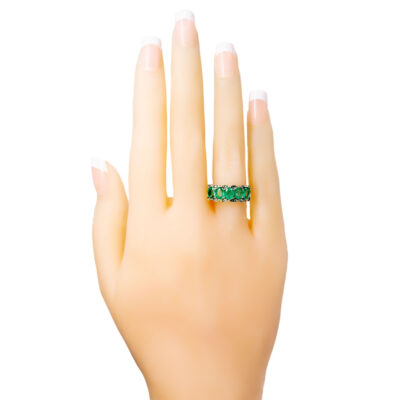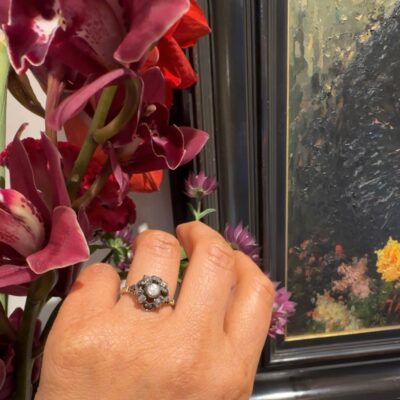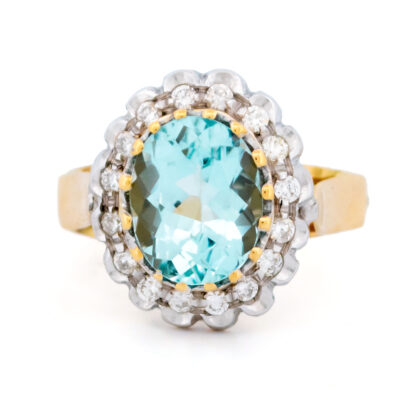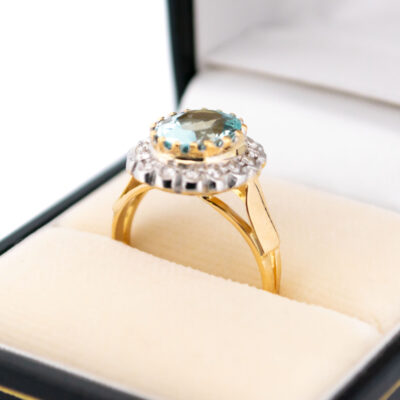This vintage Victorian-style ring is truly stunning, with an beautiful cluster design. The center of the ring features a cabochon-cut opal weighing approximately 6.50 carats, surrounded by a halo of approximately 1.10 carats of K SI1 old mine cut diamonds. The ring is made of a combination of 14k gold and silver, which adds to its vintage charm and elegance.
Videos
This vintage Victorian-style ring is truly stunning, with an beautiful cluster design. The center of the ring features a cabochon-cut opal weighing approximately 6.50 carats, surrounded by a halo of approximately 1.10 carats of K SI1 old mine cut diamonds. The ring is made of a combination of 14k gold and silver, which adds to its vintage charm and elegance.
Details: ±6.50ct Opal, ±1.10ct (K SI1) Old-mine-cut diamonds, 14k, Silver Ring
Size: 17.93 NL / 56.3 FR / 7¾ US / P UK
Dimensions: H 0.9 x L 1.8 x W 2.3 cm.
Weight in grams: 5.7.
Condition: Very good condition – slightly used with small signs of wear.
| Design Era | |
|---|---|
| Design & Historical Context | The Victorian Era was a time of great cultural and artistic flourishing in England, and this was reflected in the jewelry of the time. During the Victorian Era, a middle class began to emerge, which sparked a demand for jewelry in the mass market. Jewelry trends during this time often reflected the tone of current events. The Victorian Era is usually divided into three subsections: the Romantic Period (1837-1861), the Grand Period (1861-1880), and the Aesthetic Period (1880-1901). During the Romantic Period, jewelry featured nature-inspired designs similar to those of the Georgian era, and was characterized by its intricate and delicate detailing. Lockets and brooches were popular for daytime wear, while colored gemstones and diamonds were worn in the evening. During the Grand Period, known as the Mid-Victorian era, jewelry was often influenced by the death of Queen Victoria's husband. Many jewelry pieces from this period have solemn, somber designs and feature heavy, dark stones such as jet, onyx, amethyst, and garnet. This period also saw the emergence of highly creative, colorful designs using shells, mosaics, and gemstones. During the Aesthetic Period, jewelers used diamonds and feminine, bright gemstones such as sapphire, peridot, and spinel. Star and crescent designs, as well as elaborate hat pins, were also popular. Some scholars believe that the Aesthetic Period began earlier, in 1875, and ended as early as 1890. |
| Key Materials | |
| Materials & Craftsmanship | Opal: The Gem of Fire and Illusion Opal is a gemstone unlike any other, renowned for its mesmerizing play of color that seems to shift and dance with every movement. This captivating stone comes in a variety of colors, from milky whites and soft pinks to deep blacks and fiery reds, all displaying a unique iridescence known as "opalescence." Opal has a rich history and has been prized by many cultures for its mystical qualities. The ancient Romans believed opals brought good luck, while in medieval Europe, they were considered a symbol of hope, purity, and truth. The word "opal" itself is derived from the Greek word "opallios," meaning "to see a change in color," a fitting name for this ever-changing gem. In the world of jewelry, opal is valued for its unique beauty and variety. Though relatively soft, with a Mohs hardness of 5.5 to 6.5, opals are often set in protective settings to preserve their delicate structure. They are used in rings, earrings, pendants, and brooches, where their shifting colors add a dynamic and ethereal quality to each piece. Opal is more than just a gemstone; it is a symbol of creativity, spontaneity, and emotional expression. Its stunning play of color and rich historical background make it a cherished and enchanting choice for jewelry that captures the imagination. Old-mine-cut diamond: The Vintage Gem of Nostalgia and Charm The Old Mine-cut diamond is a captivating choice for those who appreciate the charm and character of vintage jewelry. Known for its distinctively antique look, this cut dates back to the 18th century and was the precursor to the modern brilliant cut. Old Mine-cut diamonds are characterized by their slightly cushion-like shape, high crown, small table, deep pavilion, and large, open culet, all of which contribute to their unique and romantic appeal. Historically, the Old Mine cut was the most popular diamond cut during the Georgian and Victorian eras. These diamonds were cut by hand, long before the advent of modern cutting technology, which means each stone has its own unique proportions and personality. The cut was designed to maximize the diamond’s brilliance under candlelight, giving it a warm, glowing sparkle that has captivated jewelry lovers for centuries. In modern times, Old Mine-cut diamonds are cherished for their vintage elegance and historical significance. Their distinctive appearance, with a smaller table and larger facets, produces a softer, more subdued brilliance compared to modern cuts, which adds to their old-world charm. These diamonds are often found in antique and heirloom jewelry, such as engagement rings, brooches, and pendants, where their timeless beauty can be fully appreciated. An Old Mine-cut diamond is more than just a gemstone; it is a piece of history, reflecting the craftsmanship and artistry of a bygone era. Its nostalgic appeal and unique sparkle make it a perfect choice for those who seek a diamond that tells a story and exudes vintage elegance and charm. 14k: The Durable Choice for Everyday Elegance 14k gold is a popular and practical choice in fine jewelry, known for its durability, affordability, and beautiful color. The "14k" signifies that the gold is composed of 58.3% pure gold and 41.7% alloyed metals, such as copper, silver, nickel, or zinc. This combination results in a strong and resilient material that can withstand the rigors of daily wear, making it an ideal option for those seeking both beauty and durability. Historically, gold has always been a symbol of wealth and luxury, and 14k gold strikes a perfect balance between the rich appearance of gold and the strength needed for everyday use. Because of its lower gold content compared to 18k or 24k gold, 14k gold is more affordable, making it a popular choice for a wide range of jewelry pieces. In modern jewelry, 14k gold is appreciated for its versatility and variety. It is available in several colors, each achieved by mixing gold with different metals: Yellow Gold: A classic and timeless choice, 14k yellow gold has a warm, golden hue that complements most skin tones and is well-suited for both modern and traditional designs. White Gold: Created by alloying gold with white metals like nickel or palladium, 14k white gold has a sleek, silver-like appearance. It is often rhodium-plated for added shine and is a popular choice for engagement rings and other contemporary jewelry. Rose Gold: Achieved by mixing gold with copper, 14k rose gold has a soft, pinkish hue that has gained popularity for its romantic and vintage appeal. It is a favorite for those seeking a unique and stylish alternative to traditional gold colors. 14k gold is commonly used in a wide array of jewelry, including rings, necklaces, bracelets, earrings, and watches. Its durability makes it especially suitable for pieces that are worn daily, such as wedding bands and engagement rings, where the balance between strength and beauty is crucial. 14k gold is more than just a practical choice; it is a symbol of enduring style and everyday luxury. Its ability to retain the look of gold while offering greater resistance to scratches and dents makes 14k gold a versatile and timeless option for any jewelry collection. Whether in a simple band or an elaborate design, 14k gold offers a perfect blend of elegance and durability that can be enjoyed for years to come. Silver: The Metal of Elegance and Versatility Silver, known for its bright, reflective luster, is one of the most beloved and widely used precious metals in the world. This versatile metal has been cherished for thousands of years, not only for its beauty but also for its malleability, making it ideal for crafting intricate and delicate jewelry designs. Historically, silver has been associated with the moon and considered a symbol of purity, clarity, and protection. Ancient civilizations, from the Egyptians to the Greeks and Romans, valued silver for its beauty and used it to create coins, jewelry, and religious artifacts. In many cultures, silver is also believed to have healing properties, often used in amulets and talismans to ward off negative energy. In modern jewelry, silver is prized for its affordability, versatility, and timeless appeal. Sterling silver, an alloy of 92.5% pure silver and 7.5% other metals (usually copper), is the standard used in high-quality jewelry. Its durability and bright, reflective surface make it an excellent choice for a wide range of designs, from minimalist pieces to ornate creations. Silver can be polished to a high shine or given a matte, oxidized, or antiqued finish to suit various styles. Silver is more than just a metal; it is a symbol of elegance, flexibility, and understated luxury. Its enduring popularity and wide-ranging applications make it a staple in jewelry that can complement any look, from casual to formal, with timeless grace. |
| Size | |
| Dimensions | H 0.9 x L 1.8 x W 2.3 cm |
| Gender | |
| Weight (in grams) | 5.7 |
| Condition | Very good condition – slightly used with small signs of wear |
By following these tips, you can enjoy your precious jewelry for many years to come.
Related Products
-
Peridot Diamond 14k Silver Cluster Ring 14609-8378
€ 3.695,00 VAT incl. (where applicable) -
Diamond Peridot 14k Silver Cluster Ring 14610-8379
€ 1.995,00 VAT incl. (where applicable) -
Diamond 9k Silver Cluster Ring 11052-6253
€ 1.495,00Original price was: € 1.495,00.€ 1.100,00Current price is: € 1.100,00. VAT incl. (where applicable) -
Emerald Diamond 14k Silver Cluster Ring 12730-8008
€ 2.995,00 VAT incl. (where applicable) -
Diamond Sapphire 18k Cluster Ring 18127-9467
€ 1.795,00 VAT incl. (where applicable) -
Diamond Emerald Silver 9k Row Ring 17925-9333
€ 1.395,00 VAT incl. (where applicable) -
Diamond 14k Silver Ring 16046-8719
€ 1.695,00 VAT incl. (where applicable) -
Aquamarine Diamond 18k Cluster Ring 15788-8636
€ 3.295,00 VAT incl. (where applicable)
- Home
- Collection
- Fine Jewelry
- Silver Jewelry
- Silverware
- Boxes
- Candlesticks
- Salt and pepper shakers
- Miniatures
- Salt cellars
- Spoon Set
- Condiments
- Frames
- Napkin Ring
- Spoon
- Oddities
- Cups
- Vases
- Cutlery
- Serving Spoon And Cake Server
- Candlesticks
- Baskets
- Hanukkiah
- Spice Tower
- Yad
- Tea Set
- Sugar Castor
- Napkin Rings
- Wine Bottle Coaster
- Wine Stopper
- Tea Pot
- Jugs
- Rattles
- Hip Flask
- Miscellaneous
- Rings 💍
- About
- Contact

